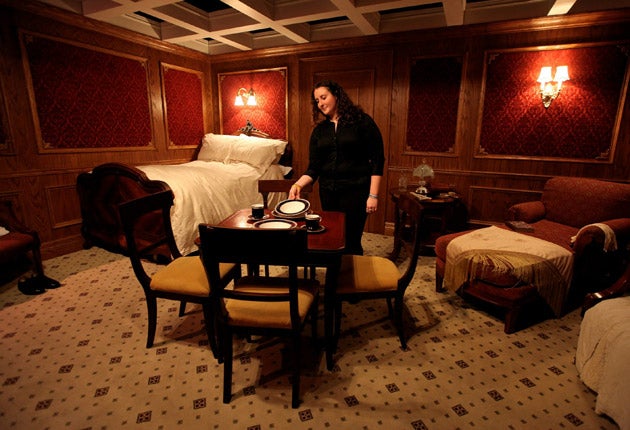Titanic: The Artefact Exhibition, O2, London
Chill spectres of luxury and poverty rise from their watery graves

Your support helps us to tell the story
From reproductive rights to climate change to Big Tech, The Independent is on the ground when the story is developing. Whether it's investigating the financials of Elon Musk's pro-Trump PAC or producing our latest documentary, 'The A Word', which shines a light on the American women fighting for reproductive rights, we know how important it is to parse out the facts from the messaging.
At such a critical moment in US history, we need reporters on the ground. Your donation allows us to keep sending journalists to speak to both sides of the story.
The Independent is trusted by Americans across the entire political spectrum. And unlike many other quality news outlets, we choose not to lock Americans out of our reporting and analysis with paywalls. We believe quality journalism should be available to everyone, paid for by those who can afford it.
Your support makes all the difference.My name is Helene Ragnhild Ostby. Aged 22, I hail from Providence, Rhode Island, and am travelling with my father, who runs a jewellery business.
We take a trip to Europe every year to keep abreast of the latest retail trends, sailing with White Star Line, first class. In the spring of 1912, we decided to try the much-advertised facilities in the latest addition to the fleet, RMS Titanic ....
This much I know from the replica boarding pass that is handed to me at the door of Titanic: The Artefact Exhibition, now installed at the O2 bubble in north Greenwich. Eighteen months from now, the sinking of the unsinkable hits its centenary. Earlier this year, the wreck and its five-mile field of debris, 453 miles south-east of Newfoundland, was declared an archeological site, which means it has now been scientifically mapped, and any future salvage attempts (there have been seven so far) will be subject to archeological procedure. Already there is fresh material in this show: HD video of the skeleton vessel, ghostly-green, algae-encrusted, and two-and-a-half miles under.
But what of the artefacts that distinguish this exhibition from what one can only guess will be a glut of other commemorative Titanic events over the next 18 months or so? In themselves, they are rather humdrum, and not even especially numerous. Since RMS Titanic Inc (RMST) began its forays to the wreck (not discovered until 1985), it has retrieved some 5,500 items. Of these, several hundred are on permanent display in Las Vegas (including a 15-ton chunk of the ship's shattered hull), and about 300 have made it to the O2. You have to wonder where the choicest bits ended up.
Unremarkable as most of these items are in themselves (a gentleman's pipe, a pair of pince-nez, playing cards, a toothpaste pot), they represent small miracles of survival, while so much human life perished. It is profoundly striking that the queen of spades should have retained its features (give or take a few brown stains) after 100 years in saline, while some 1,500 fully dressed corpses have disappeared without trace, crushed by pressure of water, consumed by marine bacteria and nibbled by crustaceans and fish.
What everyone knows about the Titanic is that the elite accommodation was top-notch. No surprises, then, in the room set showing a smart mahogany bed, plush draperies and en suite dining facilities. More revealing is the third-class set-up, with its neat wooden bunks, topped by carved finials in a nod to stylish living, with proper pillows and mattresses. This was a democratic first for the Titanic: lesser cruise ships offered budget passengers only straw to sleep on.
Other room sets are more potently atmospheric. There is a replica of the captain's deck, showing what he might have seen through the glass as he gazed out on that moonless, windless night (a lot of black, basically, pin-pricked with stars, whose light was patently too feeble to reveal an iceberg). There is a terrific suggestion of the boiler room, its row of glowing coal furnaces multiplied by mirrors to suggest the ship's 157, each tended by a "fireman" and a "trimmer", tasked with breaking up the coal into useable pieces. A typical lump the size of a beachball is on display (whether or not retrieved from the sea-bed is unclear).
At the other end of the temperature scale is a wall of ice, for the benefit of those who have trouble imagining such a thing, complete with imprints of hands into which visitors are encouraged to insert their own. Children will enjoy this, and the designers of this show have thoughtfully added child-height captions to the exhibits, worded with them in mind.
In the end, though, it's the intangible elements that reach out to you from that apocalyptic freezing scene in the early hours of 15 April 1912. Clutching your replica boarding pass, before departing you scan the wall-sized lists of names to discover the fate of your passenger. Miss Ostby, it transpires, survived, having been persuaded (possibly under protest) into one of the lifeboats. Her businessman father, Engelhart, did not. And here's a thing: among the survivors, crew outnumber first-class passengers. The lackeys were ordered into the boats, to steer them or simply set an example. They were in the habit of doing as they were told, it seems, and that humility served them well.
To 1 May (020-7536 2600)
Join our commenting forum
Join thought-provoking conversations, follow other Independent readers and see their replies
Comments